The British Intestinal Failure Alliance (BIFA)
Top Tips Article Series
Through In Touch, BIFA – a Specialist Interest Group of BAPEN – will be sharing a series of articles. Utilising the breadth of experience of the BIFA Committee, each article will deliver top tips on a variety of topics, providing you with practical, helpful advice to utilise in your day-to-day practice.

Top Tips for The Management of Iron Deficiency in Intestinal Failure
Alex Speakman, Kate Edwards, Thomas Conley, Jeremy Nightingale, Alastair Forbes and the BIFA Committee
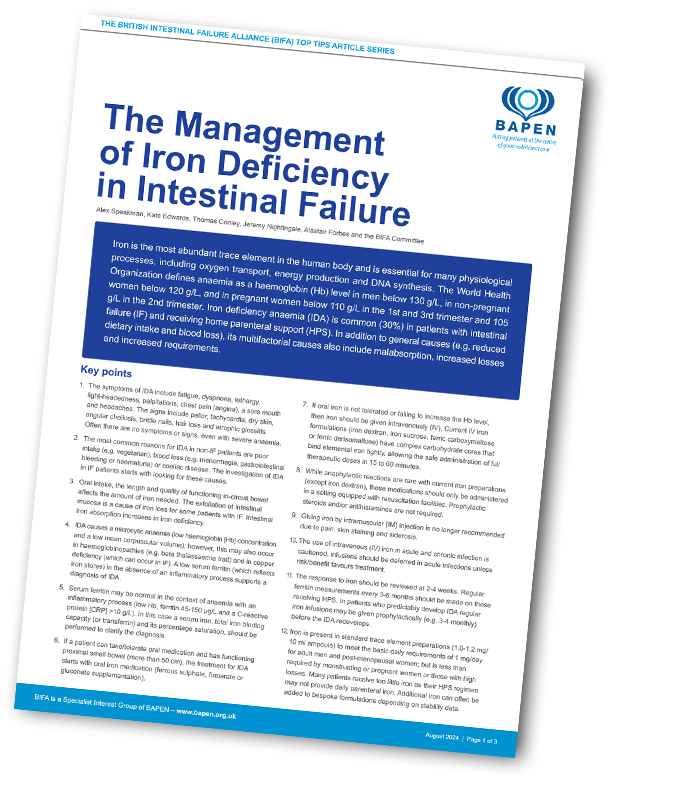
Iron is the most abundant trace element in the human body and is essential for many physiological processes, including oxygen transport, energy production and DNA synthesis. The World Health Organization defines anaemia as a haemoglobin (Hb) level in men below 130 g/L, in non-pregnant women below 120 g/L, and in pregnant women below 110 g/L in the 1st and 3rd trimester and 105 g/L in the 2nd trimester. Iron deficiency anaemia (IDA) is common (30%) in patients with intestinal failure (IF) and receiving home parenteral support (HPS). In addition to general causes (e.g. reduced dietary intake and blood loss), its multifactorial causes also include malabsorption, increased losses and increased requirements.
Click here to download the article.

Top Tips for Radiology in Intestinal Failure
Arun Gupta and the BIFA Committee
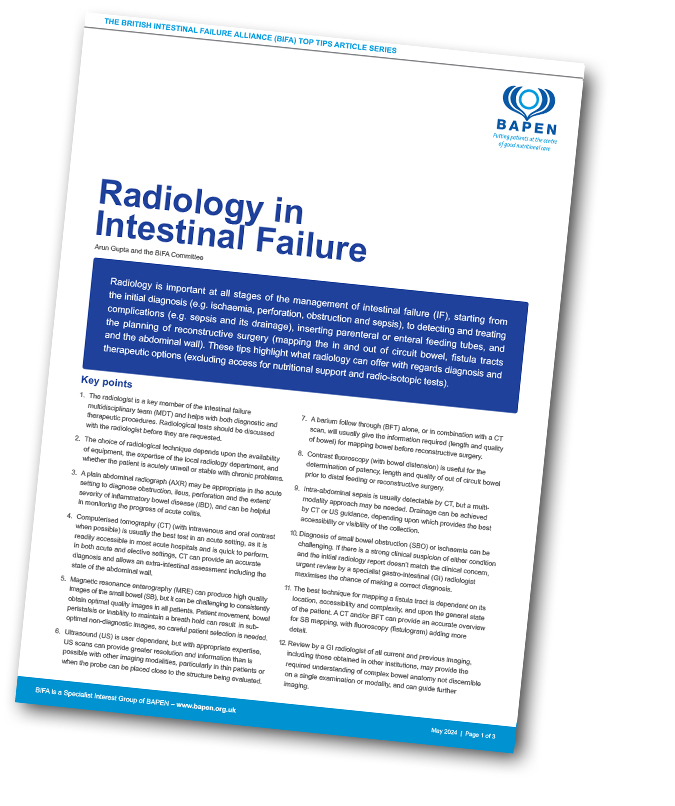
Radiology is important at all stages of the management of intestinal failure (IF), starting from the initial diagnosis (e.g. ischaemia, perforation, obstruction and sepsis), to detecting and treating complications (e.g. sepsis and its drainage), inserting parenteral or enteral feeding tubes, and the planning of reconstructive surgery (mapping the in and out of circuit bowel, fistula tracts and the abdominal wall). These tips highlight what radiology can offer with regards diagnosis and therapeutic options (excluding access for nutritional support and radio-isotopic tests).
Click here to download the article.

Top Tips for Conception and Pregnancy in Chronic Intestinal Failure
Kirstine Farrer, Simon Harrison, Ashley Bond, Antje Teubner, Alex Speakman, Jeremy Nightingale, Simon Lal and the BIFA Committee
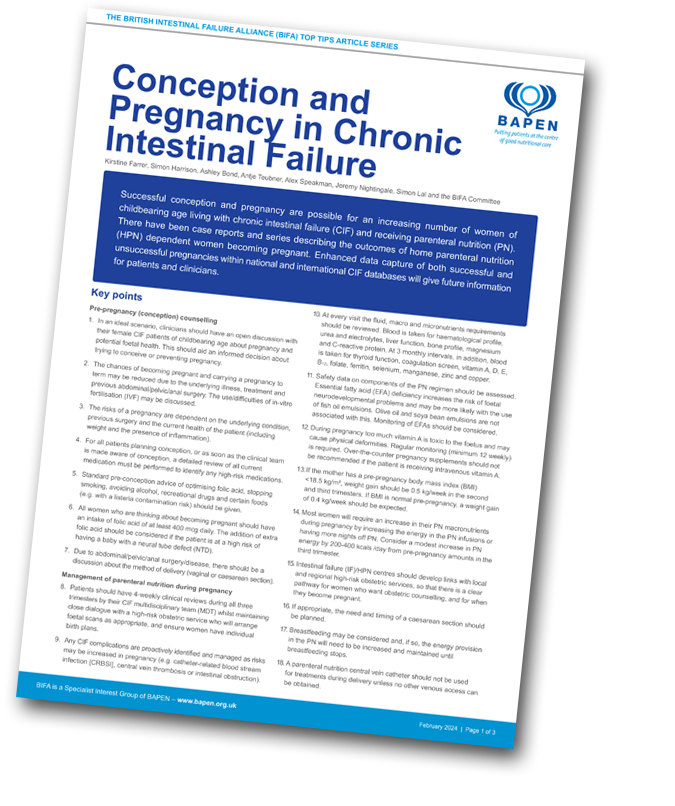
Successful conception and pregnancy are possible for an increasing number of women of childbearing age living with chronic intestinal failure (CIF) and receiving parenteral nutrition (PN). There have been case reports and series describing the outcomes of home parenteral nutrition (HPN) dependent women becoming pregnant. Enhanced data capture of both successful and unsuccessful pregnancies within national and international CIF databases will give future information for patients and clinicians.
Click here to download the article.

Top Tips for Reviewing a Patient Receiving Home Parenteral Support
Jeremy Nightingale, Mia Small, Michael Glynn and the BIFA Committee
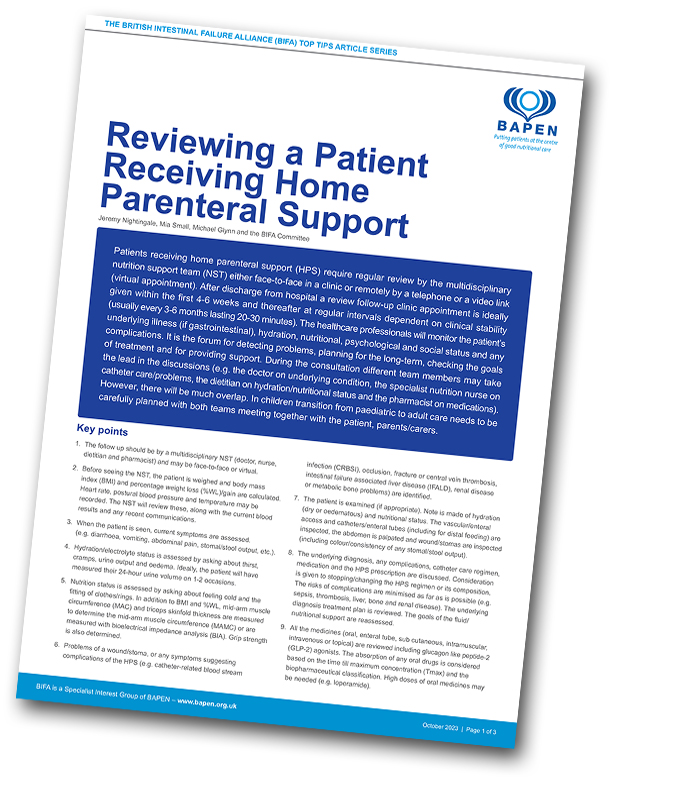
Patients receiving home parenteral support (HPS) require regular review by the multidisciplinary nutrition support team (NST) either face-to-face in a clinic or remotely by a telephone or a video link (virtual appointment). After discharge from hospital a review follow-up clinic appointment is ideally given within the first 4-6 weeks and thereafter at regular intervals dependent on clinical stability (usually every 3-6 months lasting 20-30 minutes). The healthcare professionals will monitor the patient’s underlying illness (if gastrointestinal), hydration, nutritional, psychological and social status and any complications. It is the forum for detecting problems, planning for the long-term, checking the goals of treatment and for providing support. During the consultation different team members may take the lead in the discussions (e.g. the doctor on underlying condition, the specialist nutrition nurse on catheter care/problems, the dietitian on hydration/nutritional status and the pharmacist on medications). However, there will be much overlap. In children transition from paediatric to adult care needs to be carefully planned with both teams meeting together with the patient and parents/carers.
Click here to download the article.

Top Tips for Surgical Management of a Short Bowel in Adult Patients
Phil Stevens, Gordon Carlson and the BIFA Committee
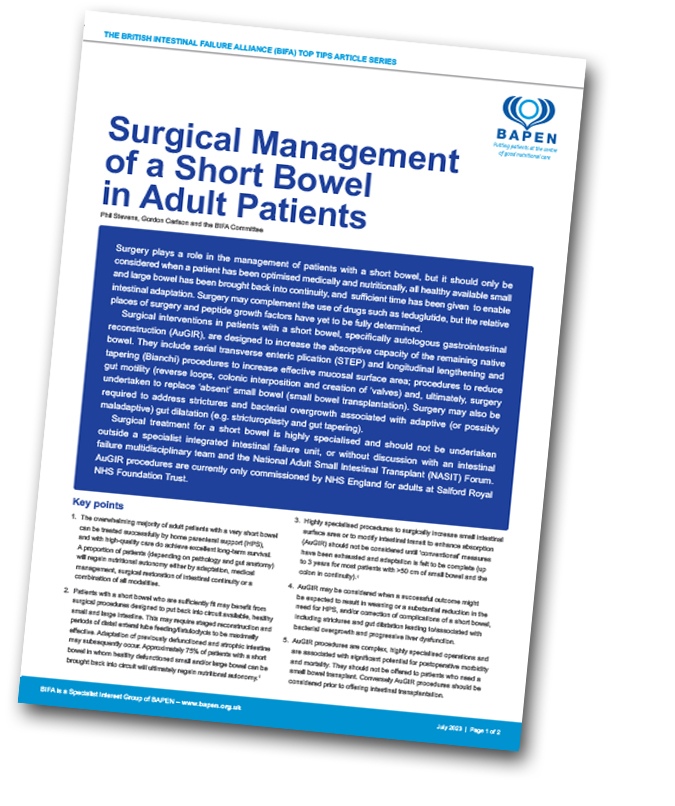
Surgery plays a role in the management of patients with a short bowel, but it should only be considered when a patient has been optimised medically and nutritionally, all healthy available small and large bowel has been brought back into continuity, and sufficient time has been given to enable intestinal adaptation. Surgery may complement the use of drugs such as teduglutide, but the relative places of surgery and peptide growth factors have yet to be fully determined.
Surgical interventions in patients with a short bowel, specifically autologous gastrointestinal reconstruction (AuGIR), are designed to increase the absorptive capacity of the remaining native bowel. They include serial transverse enteric plication (STEP) and longitudinal lengthening and tapering (Bianchi) procedures to increase effective mucosal surface area; procedures to reduce gut motility (reverse loops, colonic interposition and creation of ‘valves) and, ultimately, surgery undertaken to replace ‘absent’ small bowel (small bowel transplantation). Surgery may also be required to address strictures and bacterial overgrowth associated with adaptive (or possibly maladaptive) gut dilatation (e.g. stricturoplasty and gut tapering).
Surgical treatment for a short bowel is highly specialised and should not be undertaken outside a specialist integrated intestinal failure unit, or without discussion with an intestinal failure multidisciplinary team and the National Adult Small Intestinal Transplant (NASIT) Forum. AuGIR procedures are currently only commissioned by NHS England for adults at Salford Royal NHS Foundation Trust.
Click here to download the article.

Top Tips for Managing Kidney Stones and Nephrocalcinosis in Patients with a Short Bowel
Charlie Tomson, Jeremy Nightingale and the BIFA Committee
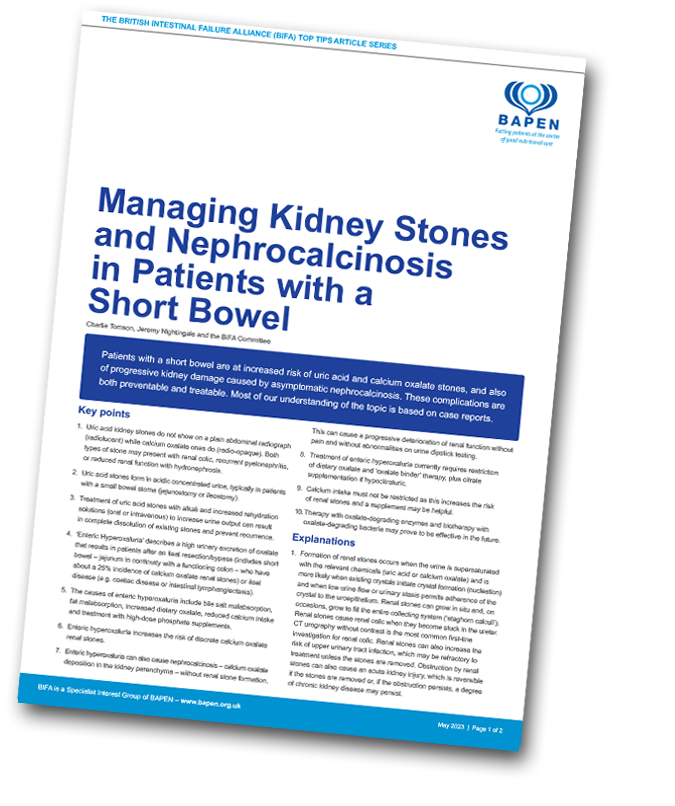
Patients with a short bowel are at increased risk of uric acid and calcium oxalate stones, and also of progressive kidney damage caused by asymptomatic nephrocalcinosis. These complications are both preventable and treatable. Most of our understanding of the topic is based on case reports.
Click here to download the article.

Top Tips for Prescribing Multi-Chamber Bags for Parenteral Support Regimens
Simon Harrison, Kirstine Farrer, Uchu Meade, Sarah Zeraschi and the BIFA Committee
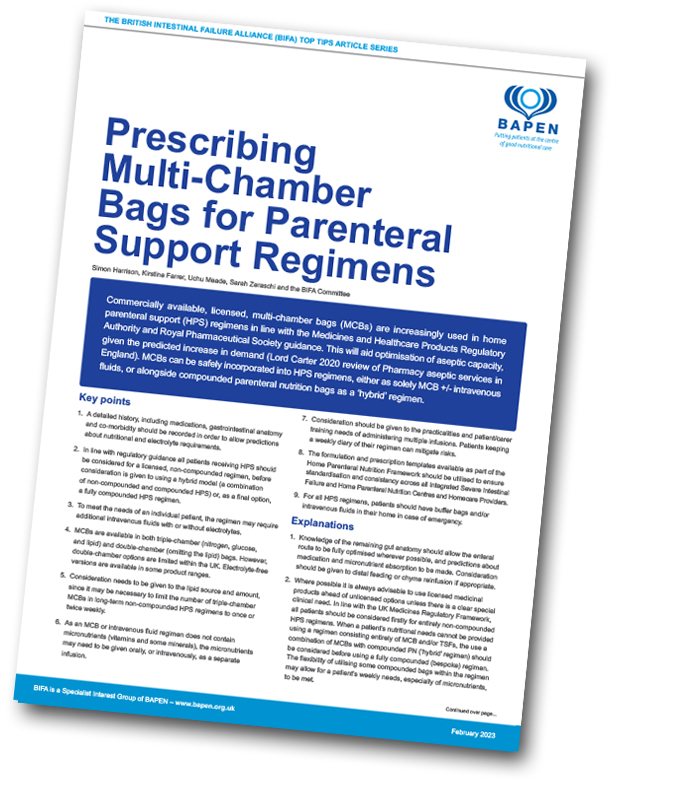
Commercially available, licensed, multi-chamber bags (MCBs) are increasingly used in home parenteral support (HPS) regimens in line with the Medicines and Healthcare Products Regulatory Authority and the Royal Pharmaceutical Society guidance. This will aid optimisation of aseptic capacity, given the predicted increase in demand (Lord Carter 2020 review of Pharmacy aseptic services in England). MCBs can be safely incorporated into HPS regimens, either as solely MCB +/- intravenous fluids, or alongside compounded parenteral nutrition bags as a ‘hybrid’ regimen.
Click here to download the article.

Top Tips for Managing Crohn’s Disease in Intestinal Failure
Jeremy Nightingale, Simon Lal, Gordon Carlson, Phil Stevens, Alison Culkin and the BIFA Committee

Crohn’s disease (CD) is a common cause for intestinal failure (IF). IF may occur in patients with CD due to extensive disease, enteric fistula(s), obstruction or a short, defunctioned or bypassed bowel. CD is a common cause of patients having a short bowel.
Click here to download the article.

Top Tips for The Management of Severe Intestinal Dysmotility
Jeremy Nightingale and the BIFA Committee
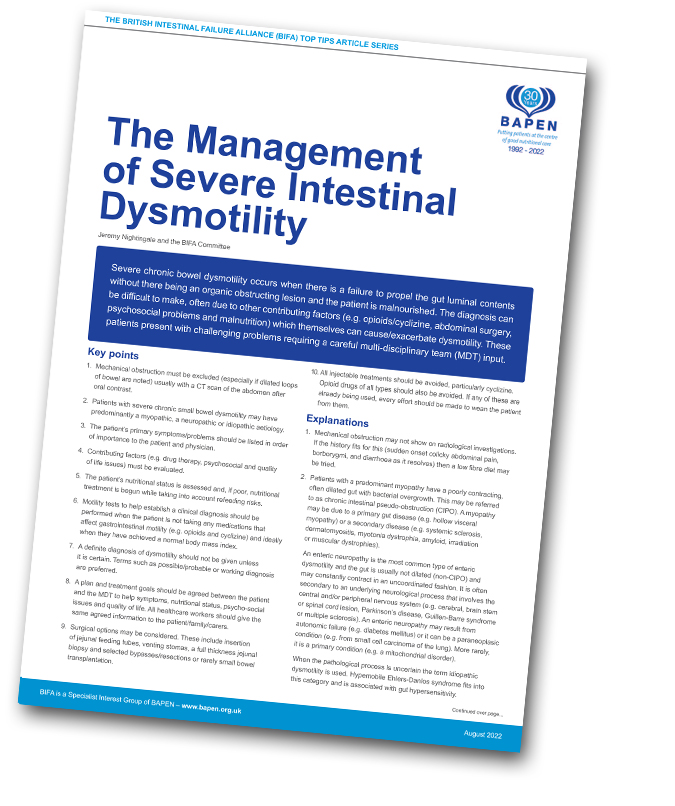
Severe chronic bowel dysmotility occurs when there is a failure to propel the gut luminal contents without there being an organic obstructing lesion and the patient is malnourished. The diagnosis can be difficult to make, often due to other contributing factors (e.g. opioids/cyclizine, abdominal surgery, psychosocial problems and malnutrition) which themselves can cause/exacerbate dysmotility. These patients present with challenging problems requiring a careful multi-disciplinary team (MDT) input.
Click here to download the article.

Top Tips for Predicting Drug Absorption in Patients with a Short Bowel
Uchu Meade, Richard Ng Kwet Shing, Jeremy Nightingale and the BIFA Committee
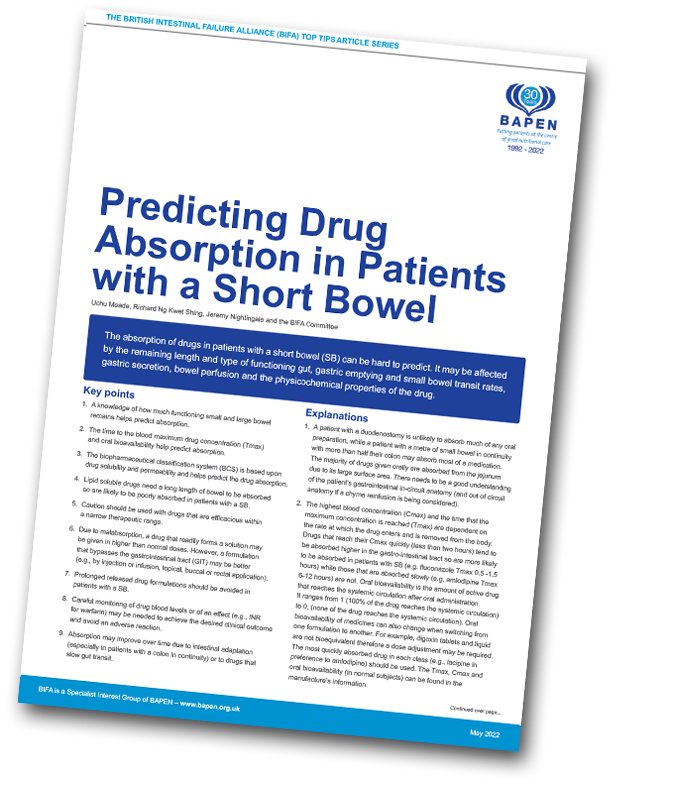
The absorption of drugs in patients with a short bowel (SB) can be hard to predict. It may be affected by the remaining length and type of functioning gut, gastric emptying and small bowel transit rates, gastric secretion, bowel perfusion and the physicochemical properties of the drug.
Click here to download the article.

Top Tips for Metabolic Bone Disease
Philip Allan, Jeremy Nightingale and the BIFA Committee
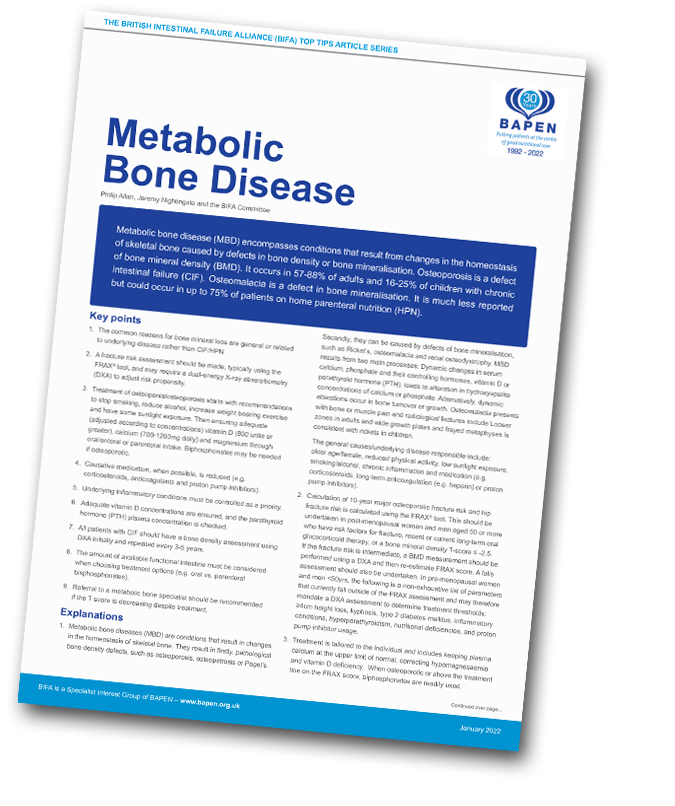
Metabolic bone disease (MBD) encompasses conditions that result from changes in the homeostasis of skeletal bone caused by defects in bone density or bone mineralisation. Osteoporosis is a defect of bone mineral density (BMD). It occurs in 57-88% of adults and 16-25% of children with chronic intestinal failure (CIF). Osteomalacia is a defect in bone mineralisation. It is much less reported but could occur in up to 75% of patients on home parenteral nutrition (HPN).
Click here to download the article.

Top Tips for Nutritional and fluid assessment of patients with Intestinal Failure
Alison Culkin, Kirstine Farrer, Jeremy Nightingale and the BIFA Committee
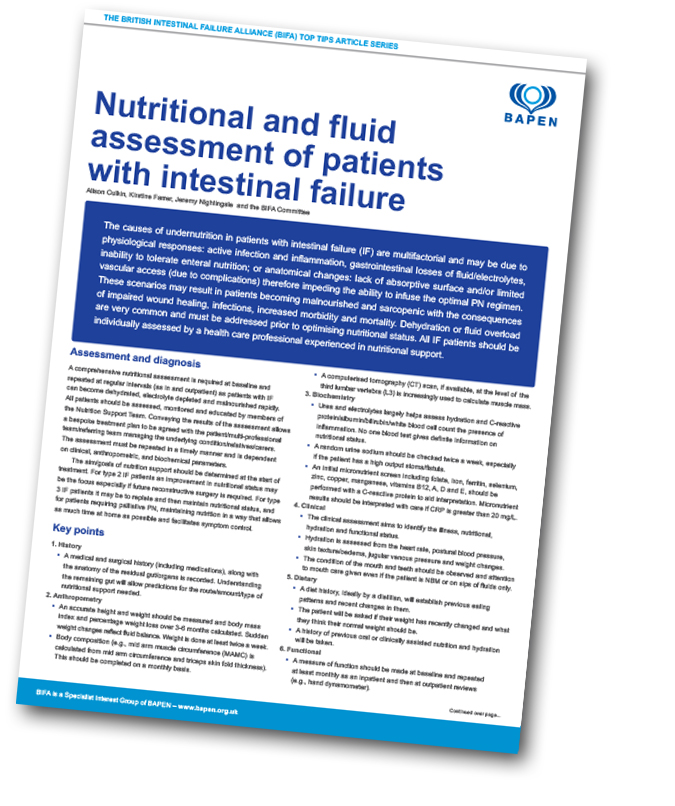
The causes of undernutrition in patients with intestinal failure (IF) are multifactorial and may be due to physiological responses: active infection and inflammation, gastrointestinal losses of fluid/electrolytes, inability to tolerate enteral nutrition; or anatomical changes: lack of absorptive surface and/or limited vascular access (due to complications) therefore impeding the ability to infuse the optimal PN regimen. These scenarios may result in patients becoming malnourished and sarcopenic with the consequences of impaired wound healing, infections, increased morbidity and mortality. Dehydration or fluid overload are very common and must be addressed prior to optimising nutritional status. All IF patients should be individually assessed by a health care professional experienced in nutritional support.
Click here to download the article.

Top Tips for Management of Type 2 (Medium Term Reversible) Intestinal Failure
Jeremy Nightingale, Akash Mehta, Phil Stevens, Gordon Carlson and the BIFA Committee
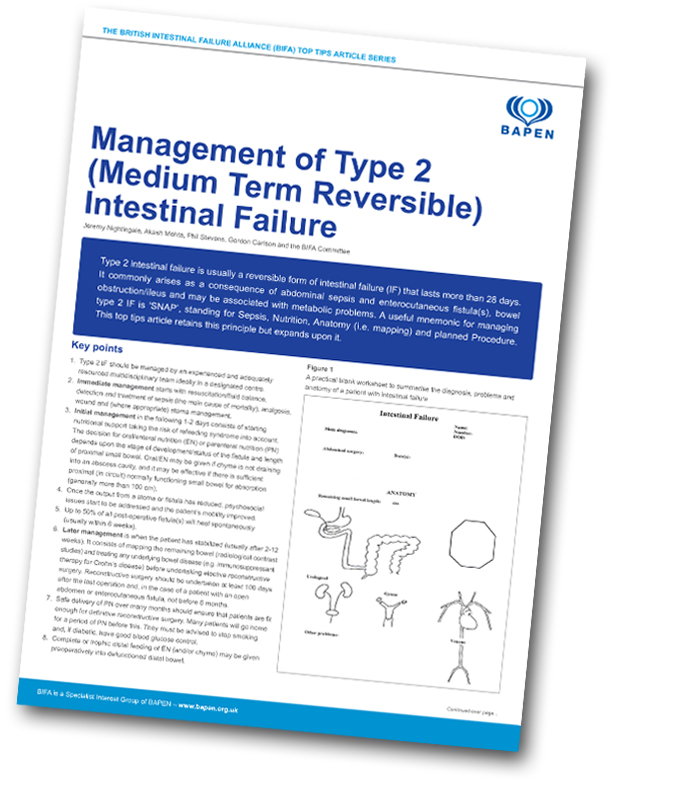
Type 2 intestinal failure is usually a reversible form of intestinal failure (IF) that lasts more than 28 days. It commonly arises as a consequence of abdominal sepsis and enterocutaneous fistula(s), bowel obstruction/ileus and may be associated with metabolic problems. A useful mnemonic for managing type 2 IF is ‘SNAP’, standing for Sepsis, Nutrition, Anatomy (i.e. mapping) and planned Procedure. This top tips article retains this principle but expands upon it.
Click here to download the article.

Top Tips for Liver Biopsy in HPN Patients – When, how and why?
Lisa Sharkey, Jeremy Nightingale and the BIFA Committee
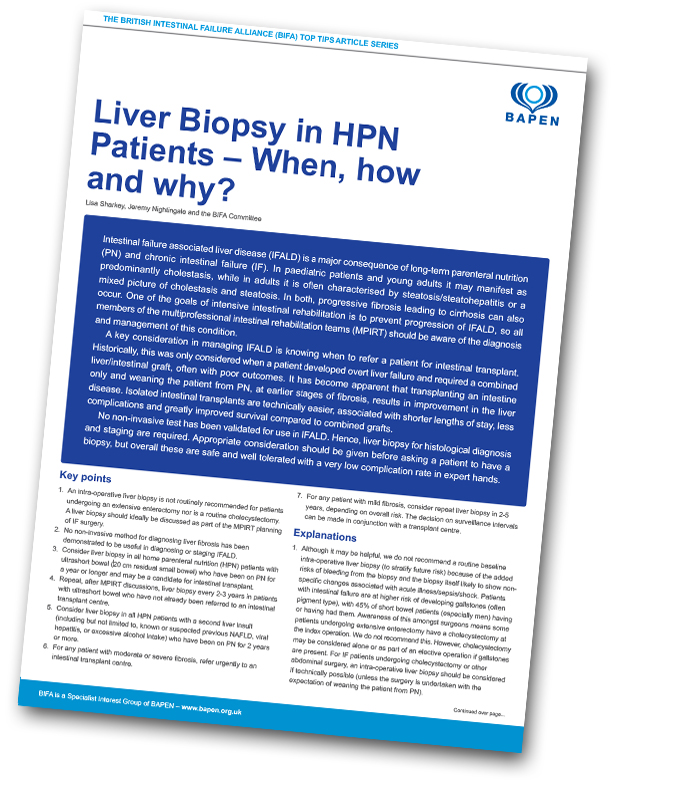
Intestinal failure associated liver disease (IFALD) is a major consequence of long-term parenteral nutrition (PN) and chronic intestinal failure (IF). In paediatric patients and young adults it may manifest as predominantly cholestasis, while in adults it is often characterised by steatosis/steatohepatitis or a mixed picture of cholestasis and steatosis. In both, progressive fibrosis leading to cirrhosis can also occur. One of the goals of intensive intestinal rehabilitation is to prevent progression of IFALD, so all members of the multiprofessional intestinal rehabilitation teams (MPIRT) should be aware of the diagnosis and management of this condition.
A key consideration in managing IFALD is knowing when to refer a patient for intestinal transplant. Historically, this was only considered when a patient developed overt liver failure and required a combined liver/intestinal graft, often with poor outcomes. It has become apparent that transplanting an intestine only and weaning the patient from PN, at earlier stages of fibrosis, results in improvement in the liver disease. Isolated intestinal transplants are technically easier, associated with shorter lengths of stay, less complications and greatly improved survival compared to combined grafts.
No non-invasive test has been validated for use in IFALD. Hence, liver biopsy for histological diagnosis and staging are required. Appropriate consideration should be given before asking a patient to have a biopsy, but overall these are safe and well tolerated with a very low complication rate in expert hands.
Click here to download the article.

Top Tips for Managing the Psychological Well-being of Adults Requiring Home Parenteral Support (HPS)
Sarah Kelly, Carolyn Wheatley and the BIFA Committee
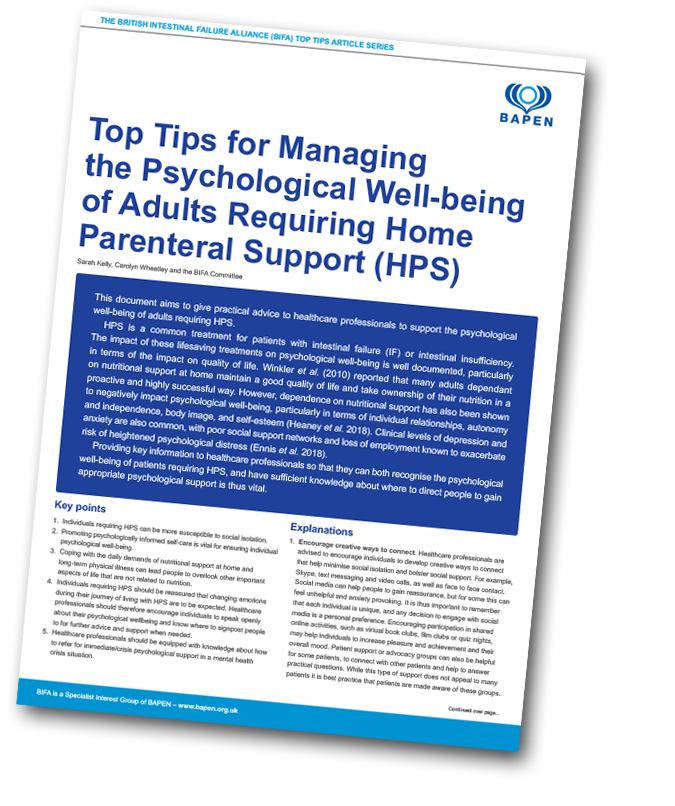
This document aims to give practical advice to healthcare professionals to support the psychological well-being of adults requiring HPS.
HPS is a common treatment for patients with intestinal failure (IF) or intestinal insufficiency. The impact of these lifesaving treatments on psychological well-being is well documented, particularly in terms of the impact on quality of life. Winkler et al. (2010) reported that many adults dependant on nutritional support at home maintain a good quality of life and take ownership of their nutrition in a proactive and highly successful way. However, dependence on nutritional support has also been shown to negatively impact psychological well-being, particularly in terms of individual relationships, autonomy and independence, body image, and self-esteem (Heaney et al. 2018). Clinical levels of depression and anxiety are also common, with poor social support networks and loss of employment known to exacerbate risk of heightened psychological distress (Ennis et al. 2018).
Providing key information to healthcare professionals so that they can both recognise the psychological well-being of patients requiring HPS, and have sufficient knowledge about where to direct people to gain appropriate psychological support is thus vital.
Click here to download the article.

Top Tips for the Use of Parenteral Nutrition in Critically Ill Patients with COVID-19
Jeremy Nightingale, Rebecca White, Nicky Wyer, Richard Leach and the BIFA Committee
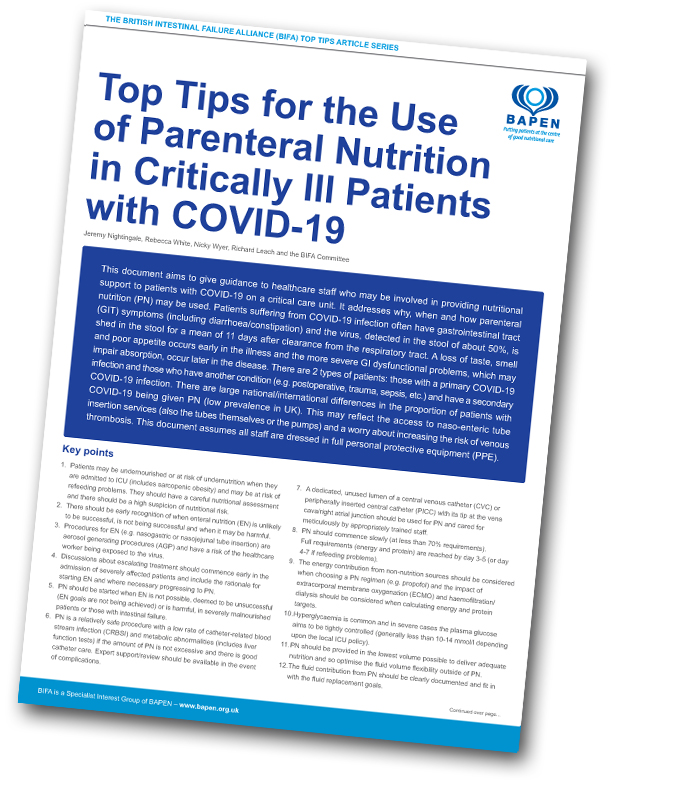
This document aims to give guidance to healthcare staff who may be involved in providing nutritional support to patients with COVID-19 on a critical care unit. It addresses why, when and how parenteral nutrition (PN) may be used. Patients suffering from COVID-19 infection often have gastrointestinal tract(GIT) symptoms (including diarrhoea/constipation) and the virus, detected in the stool of about 50%, is shed in the stool for a mean of 11 days after clearance from the respiratory tract. A loss of taste, smell and poor appetite occurs early in the illness and the more severe GI dysfunctional problems, which may impair absorption, occur later in the disease. There are 2 types of patients: those with a primary COVID-19 infection and those who have another condition (e.g. postoperative, trauma, sepsis, etc.) and have a secondary COVID-19 infection. There are large national/international differences in the proportion of patients with COVID-19 being given PN (low prevalence in UK). This may reflect the access to naso-enteric tube insertion services (also the tubes themselves or the pumps) and a worry about increasing the risk of venous thrombosis. This document assumes all staff are dressed in full personal protective equipment (PPE).
Click here to download the article.

Top Tips for the Oral/enteral Nutrition and Home Parenteral Support for Patients with Small Bowel Obstruction due to Advanced Malignancy during the COVID-19 Pandemic
Lucy Eldridge, Kirstine Farrer, Loraine Gillespie, Jessica Bower, Clare Shaw and the BIFA Committee
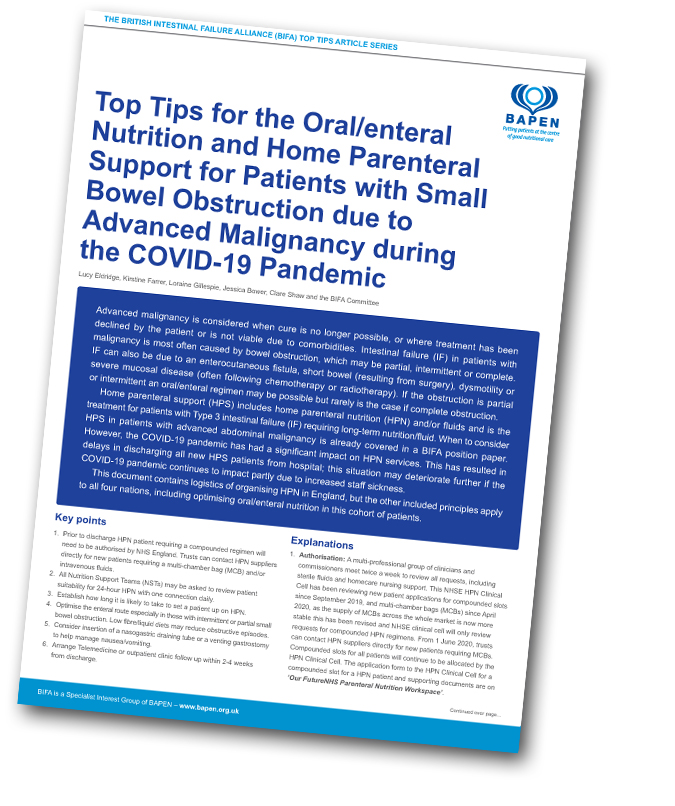
Advanced malignancy is considered when cure is no longer possible, or where treatment has been declined by the patient or is not viable due to comorbidities. Intestinal failure (IF) in patients with malignancy is most often caused by bowel obstruction, which may be partial, intermittent or complete. IF can also be due to an enterocutaneous fistula, short bowel (resulting from surgery), dysmotility or severe mucosal disease (often following chemotherapy or radiotherapy). If the obstruction is partial or intermittent an oral/enteral regimen may be possible but rarely is the case if complete obstruction.
Home parenteral support (HPS) includes home parenteral nutrition (HPN) and/or fluids and is the treatment for patients with Type 3 intestinal failure (IF) requiring long-term nutrition/fluid. When to consider HPS in patients with advanced abdominal malignancy is already covered in a BIFA position paper. However, the COVID-19 pandemic has had a significant impact on HPN services. This has resulted in delays in discharging all new HPS patients from hospital; this situation may deteriorate further if the COVID-19 pandemic continues to impact partly due to increased staff sickness.
This document contains logistics of organising HPN in England, but the other included principles apply to all four nations, including optimising oral/enteral nutrition in this cohort of patients.
Click here to download the article.

Top Tips for the Transition of Adolescent and Young Persons on Home Parenteral Nutrition
Theodoric Wong, Louise McLoughlin, Elaine Sexton, Michael Glyn, Philip J Smith and the BIFA Committee
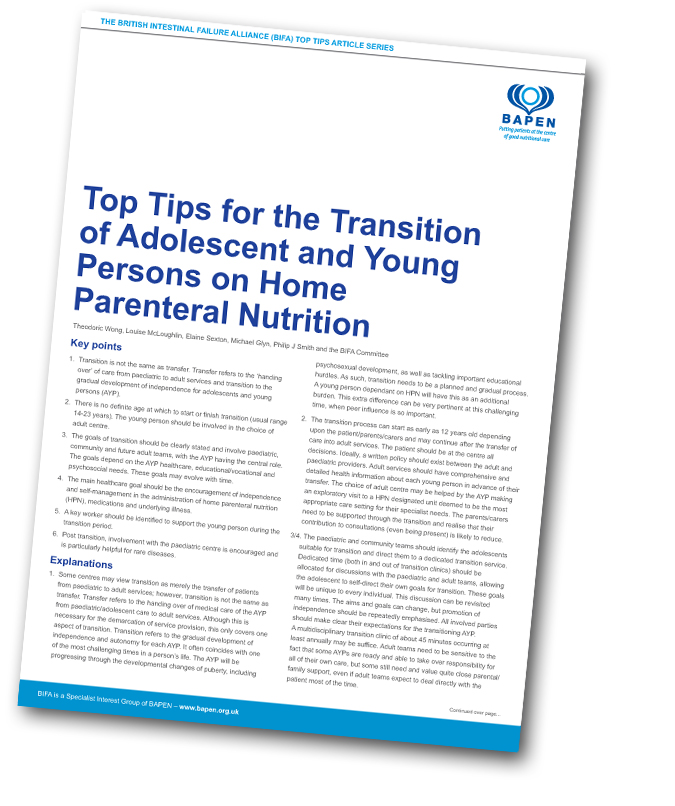
Transition is not the same as transfer. Transfer refers to the ‘handing over’ of care from paediatric to adult services and transition to the gradual development of independence for adolescents and young persons. This Top Tips article provides practical guidance on the transition of adolescent and young persons on home parenteral nutrition.
Click here to download the article.

Top Tips for Distal Enteral Tube Feeding
Kirstine Farrer, Alison Culkin, Mia Small, Jeremy Nightingale and the BIFA Committee
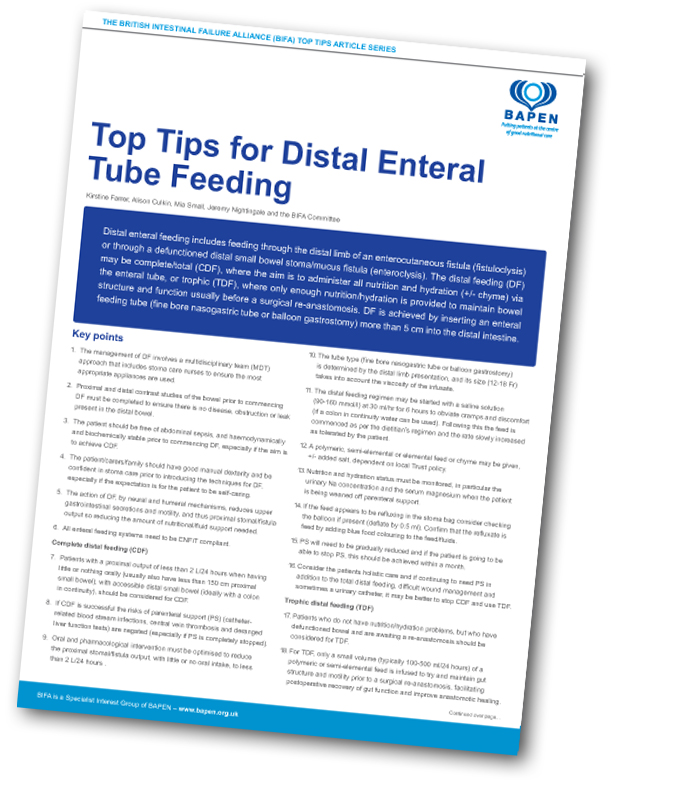
Distal enteral feeding includes feeding through the distal limb of an enterocutaneous fistula (fistuloclysis) or through a defunctioned distal small bowel stoma/mucus fistula (enteroclysis). The distal feeding (DF) may be complete/total (CDF), where the aim is to administer all nutrition and hydration (+/- chyme) via the enteral tube, or trophic (TDF), where only enough nutrition/hydration is provided to maintain bowel structure and function usually before a surgical re-anastomosis. DF is achieved by inserting an enteral feeding tube (fine bore nasogastric tube or balloon gastrostomy) more than 5 cm into the distal intestine.
Click here to download the article.

Top Tips for Discharging a Patient on Home Parenteral Support in England
Kirstine Farrer, Cathy Cawley, Angela Page, Michael Taylor, and the BIFA Committee
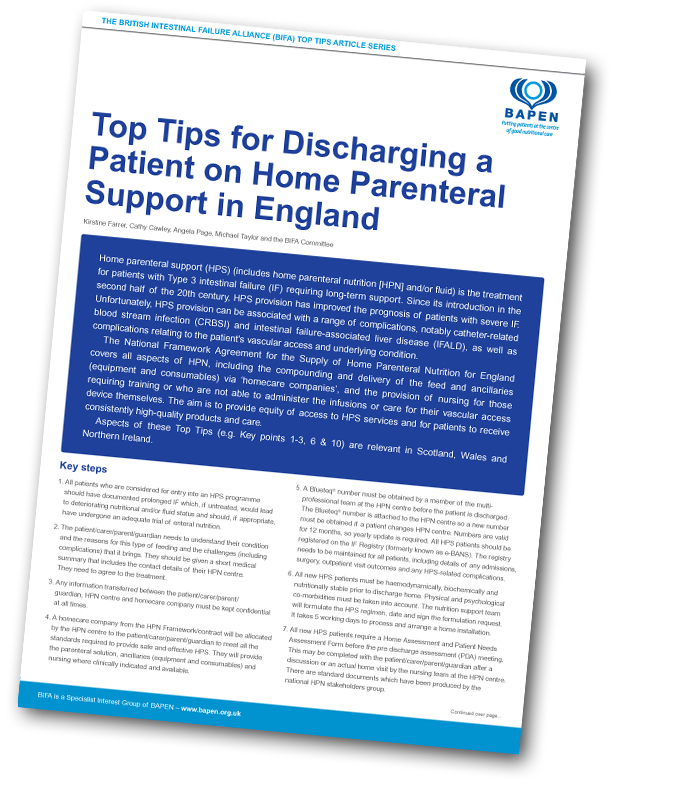
Home parenteral support (HPS) (includes home parenteral nutrition [HPN] and/or fluid) is the treatment for patients with Type 3 intestinal failure (IF) requiring long-term support. Since its introduction in the second half of the 20th century, HPS provision has improved the prognosis of patients with severe IF. Unfortunately, HPS provision can be associated with a range of complications, notably catheter-related blood stream infection (CRBSI) and intestinal failure-associated liver disease (IFALD), as well as complications relating to the patient's vascular access and underlying condition.
The National Framework Agreement for the Supply of Home Parenteral Nutrition for England covers all aspects of HPN, including the compounding and delivery of the feed and ancillaries(equipment and consumables) via ‘homecare companies’, and the provision of nursing for those requiring training or who are not able to administer the infusions or care for their vascular access device themselves. The aim is to provide equity of access to HPS services and for patients to receive consistently high-quality products and care.
Click here to download the article.

Top Tips for Preventing and Managing Refeeding Syndrome
Jeremy Nightingale, Peter Turner, Aminda De Silva, and the BIFA Committee
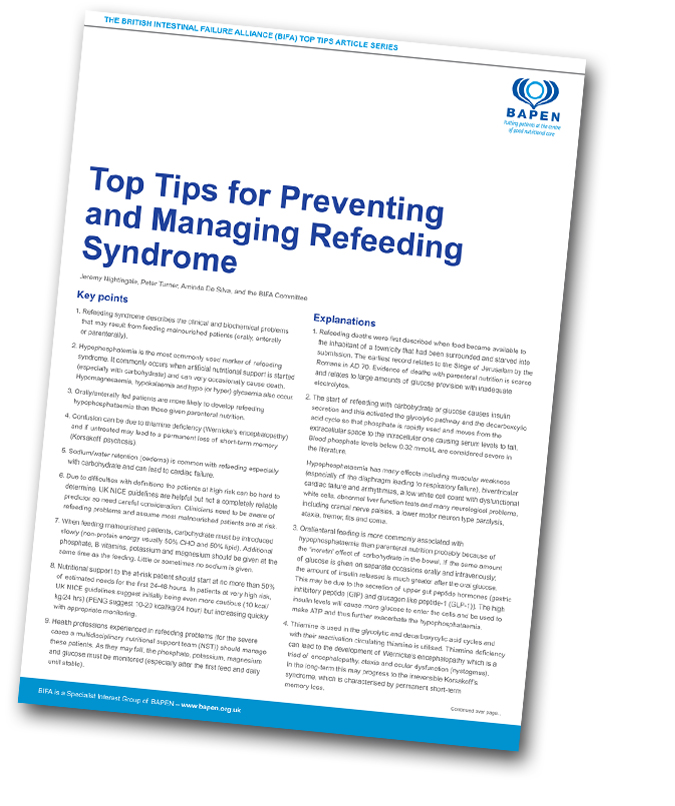
Refeeding syndrome describes the clinical and biochemical problems that may result from feeding malnourished patients (orally, enterally or parenterally).
Click here to download the article.

Top Tips for Managing Catheter-Related Blood Stream Infection in Patients Receiving Home Parenteral Support
Anabelle Cloutier, Simon Lal, Jeremy Nightingale, and the BIFA Committee
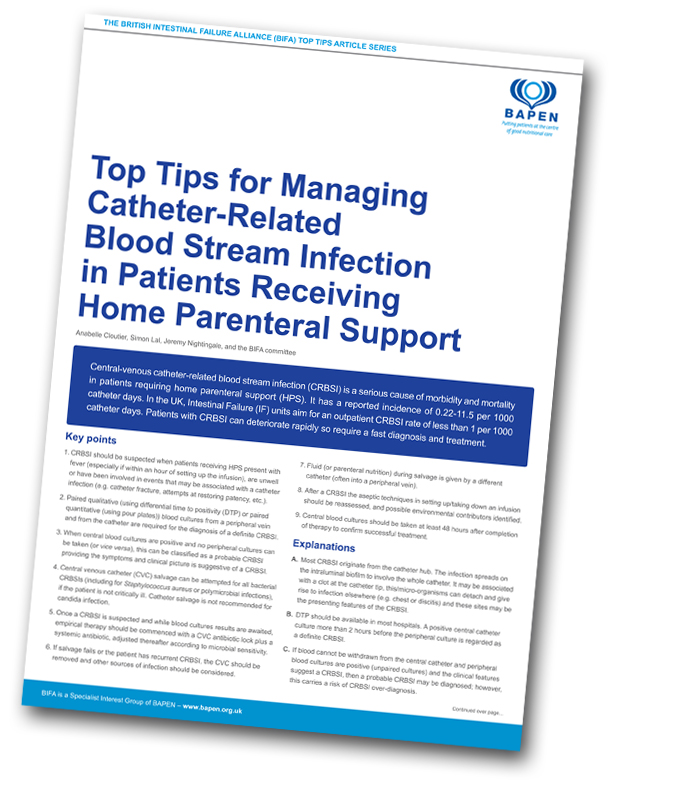
Central-venous catheter-related blood stream infection (CRBSI) is a serious cause of morbidity and mortality in patients requiring home parenteral support (HPS). It has a reported incidence of 0.22-11.5 per 1000 catheter days. In the UK, Intestinal Failure (IF) units aim for an outpatient CRBSI rate of less than 1 per 1000 catheter days. Patients with CRBSI can deteriorate rapidly so require a fast diagnosis and treatment.
Click here to download the article.

Top Tips for Managing Central Vein Thrombosis in Patients Receiving Parenteral Support
Jeremy Nightingale, Simon Lal, Simon Gabe, and the BIFA Committee
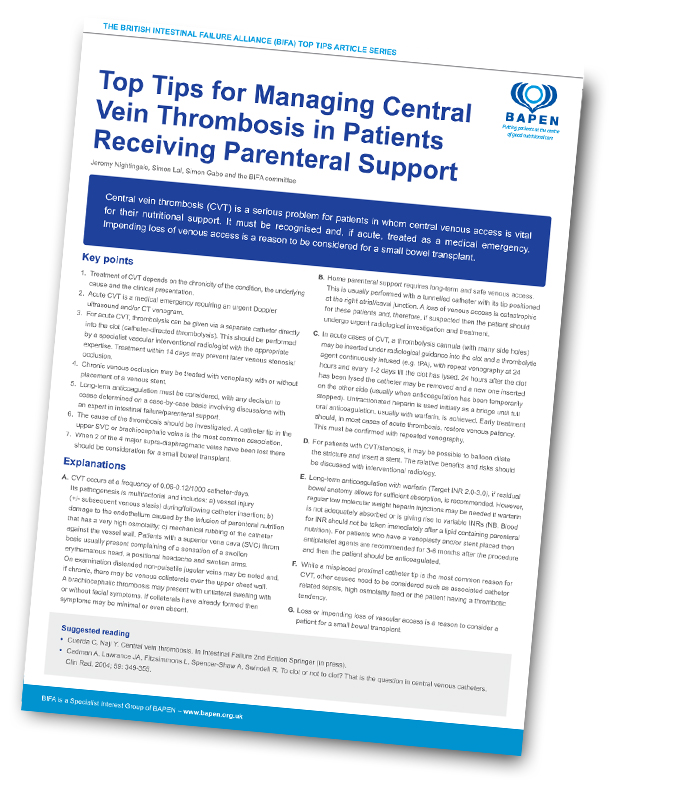
Central vein thrombosis (CVT) is a serious problem for patients in whom central venous access is vital for their nutritional support. It must be recognised and, if acute, treated as a medical emergency. Impending loss of venous access is a reason to be considered for a small bowel transplant.
Click here to download the article.

Top Tips in Adult Intestinal and Multivisceral Transplantation Referral
What, who, when, where and how?
Jeremy Woodward, and the BIFA Committee
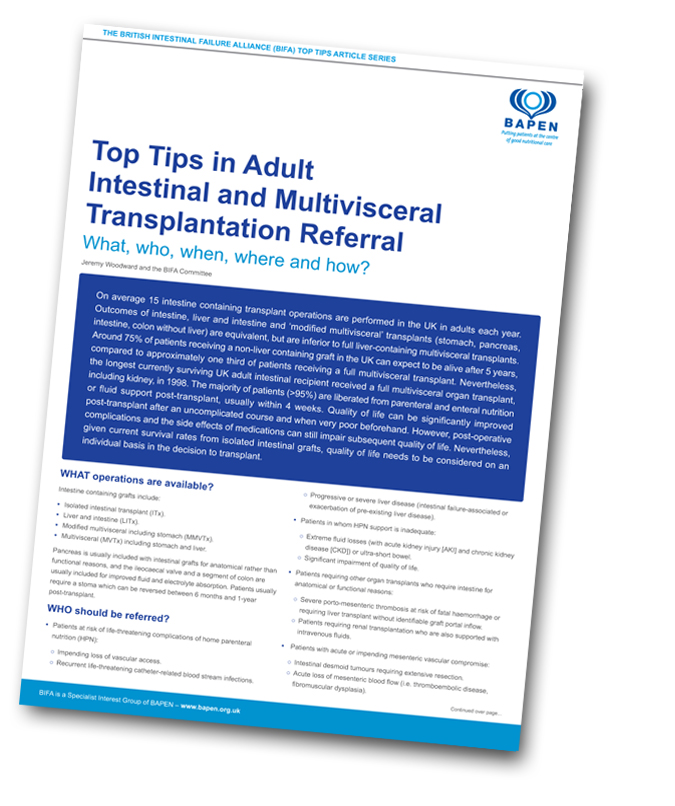
On average 15 intestine containing transplant operations are performed in the UK in adults each year. Outcomes of intestine, liver and intestine and ‘modified multivisceral’ transplants (stomach, pancreas, intestine, colon without liver) are equivalent, but are inferior to full liver-containing multivisceral transplants. Around 75% of patients receiving a non-liver containing graft in the UK can expect to be alive after 5 years, compared to approximately one third of patients receiving a full multivisceral transplant. Nevertheless, the longest currently surviving UK adult intestinal recipient received a full multivisceral organ transplant, including kidney, in 1998. The majority of patients (>95%) are liberated from parenteral and enteral nutrition or fluid support post-transplant, usually within 4 weeks. Quality of life can be significantly improved post-transplant after an uncomplicated course and when very poor beforehand. However, post-operative complications and the side effects of medications can still impair subsequent quality of life. Nevertheless, given current survival rates from isolated intestinal grafts, quality of life needs to be considered on an individual basis in the decision to transplant.
Click here to download the article.

Managing Abnormal Liver Function Tests in Patients Receiving Parenteral Nutrition
Darren Wong, and the BIFA Committee
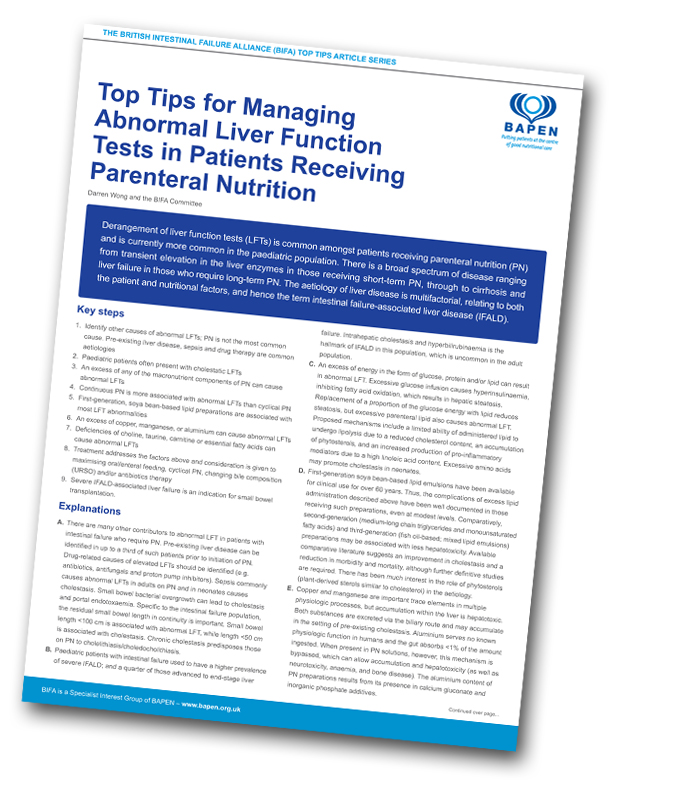
Derangement of liver function tests (LFTs) is common amongst patients receiving parenteral nutrition (PN) and is currently more common in the paediatric population. There is a broad spectrum of disease ranging from transient elevation in the liver enzymes in those receiving short-term PN, through to cirrhosis and liver failure in those who require long-term PN. The aetiology of liver disease is multifactorial, relating to both the patient and nutritional factors, and hence the term intestinal failure-associated liver disease (IFALD).
Click here to download the article.

Managing Children Receiving Long-term Parenteral Nutrition
Julian Thomas, Theodoric Wong, and the BIFA Committee
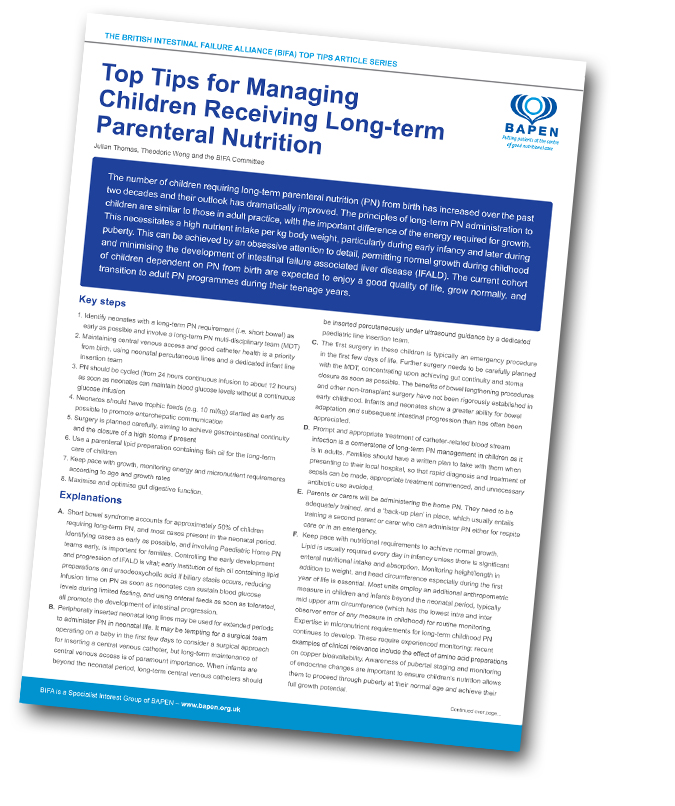
The number of children requiring long-term parenteral nutrition (PN) from birth has increased over the past two decades and their outlook has dramatically improved. The principles of long-term PN administration to children are similar to those in adult practice, with the important difference of the energy required for growth. This necessitates a high nutrient intake per kg body weight, particularly during early infancy and later during puberty. This can be achieved by an obsessive attention to detail, permitting normal growth during childhood and minimising the development of intestinal failure associated liver disease (IFALD). The current cohort of children dependent on PN from birth are expected to enjoy a good quality of life, grow normally, and transition to adult PN programmes during their teenage years.
Click here to download the article.

Managing a High Output Stoma or Fistula
Jeremy Nightingale, and the BIFA Committee
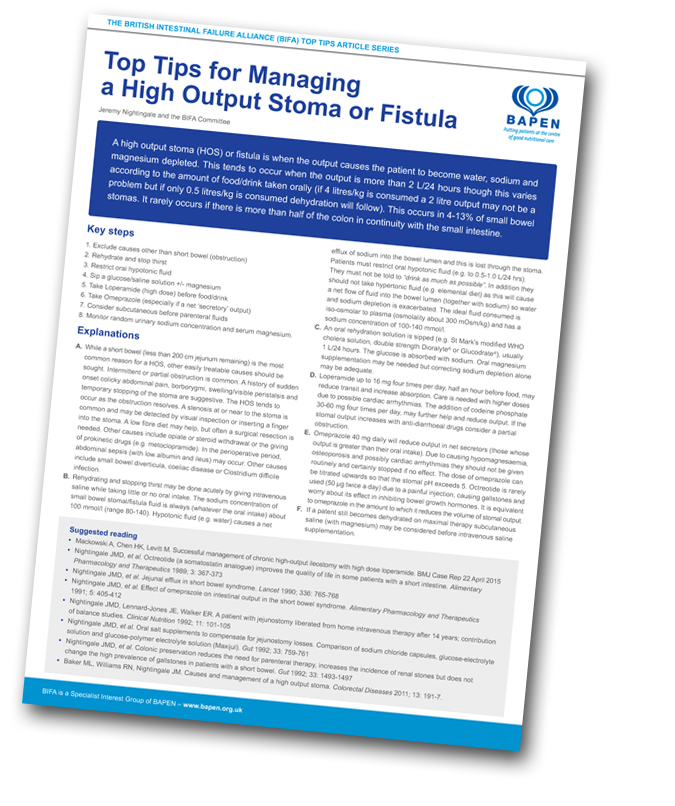
A high output stoma (HOS) or fistula is when the output causes the patient to become water, sodium and magnesium depleted. This tends to occur when the output is more than 2 L/24 hours though this varies according to the amount of food/drink taken orally (if 4 litres/kg is consumed a 2 litre output may not be a problem but if only 0.5 litres/kg is consumed dehydration will follow). This occurs in 4-13% of small bowel stomas. It rarely occurs if there is more than half of the colon in continuity with the small intestine.
Click here to download the article.
